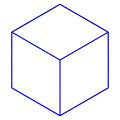4D Visualization
On the Nature of Vision
Since we're interested in visualizing 4D, let's take a more careful look at vision itself.
A Deficient Vision
As mentioned in the previous chapter, we 3D beings have a 2D retina, whereas a hypothetical 2D being only has a 1D retina. We are able to see the entirety of a 2D image, whereas a 2D being can only see a 1D projection of it at a time. For example, when we look at a square, we see this:

Since a square is a 2D object, and 2D beings are obviously familiar with 2D objects, we may think that this is how a 2D being would see a square, too.
However, when a 2D being looks at the same square, it actually sees only this:

This thin line is actually the square viewed edge-on. This is the only view the 2D being can have of the square, because it is unable to leave the 2D plane and observe the square from a 3D point of view.
When we 3D beings look at the square from our 3D vantage point, we can see all 4 edges of the square and all 4 corners at the same time. But the 2D being can see at most only two of the square's edges. It would need to walk around the square and look at it from different angles before it can see all 4 edges and all 4 corners.
Furthermore, it may not be able to tell from a single glance whether something is a square or something else, say a pentagon. It may be able to infer the 2D slope of the edges from the way light falling on the edge illuminates it, and, by doing so for each of the edges, infer that they are meeting at right angles, and thus deduce that the object is likely to be a square. However, it would need to walk around the object and look at it thoroughly before it could be sure that it's a square and not some other shape.
Why is this important?
The Appearance of Diagrams
This seemingly trivial point has far-reaching consequences when learning to visualize higher dimensions. To see why this is so, consider how we 3D beings may try to explain what a cube is to a 2D being. Since a 2D being cannot see the cube directly, we may try to draw a 2D diagram of a cube, thus:

This diagram is entirely contained in a 2D surface, so we may imagine that the 2D being would see it as we do: a hexagon with three lines within, meeting at the center. However, this is what the 2D being actually sees:

If you look at this line very carefully, you will notice subtle variations in shading, based on which the 2D being can tell the edges apart. At most two or three of the outer edges of the diagram can be seen at a time. Even after walking around the diagram and looking at it from every angle, the most the 2D being can discern is that the diagram is a hexagon: it cannot see the three edges inside the diagram at all!
To help our 2D being see the entire diagram, we would need to erase parts of the edges so that it can walk into the hexagon and explore the 3 quadrilateral “rooms” within it, thus forming a kind of mental “floor plan” of our diagram. Alternatively, we would have to construct the outer edges of the hexagon with some semi-transparent material, so that the 2D being can see through it and discern the 3 inner edges.
In other words, what is to us an obvious diagram of a cube is far from obvious from the 2D being's point of view. We see the diagram of the cube from our “overhead” 3D point of view, and can see every part of it simultaneously. The 2D being has no such luxury; it has to painstakingly explore each part of the diagram separately, and concessions such as holes in edges through which it can pass, or transparency in some of its edges, must be made in order to ease this process.
Floor Plans
Why should we care about a hypothetical 2D being's deficient vision, since we 3D beings do not suffer from such crippling limitations? This is because a similar situation applies to us when we attempt to visualize higher dimensions.
As we begin to explore the methods of visualizing 4D, we will be making much use of 3D diagrams and images that depict higher-dimensional objects—much like our diagram of the cube above is a 2D depiction of the cube, not the 3D cube itself. However, we can't draw 3D diagrams on a 2D computer screen, and even if we could, our eyes can only see a 2D representation of them at a time. So we are in a similar situation to the 2D being looking at a 2D diagram: we can only see a 2D representation of the 3D diagram, not the 3D diagram itself.
This point is very important to keep in mind as we begin to explore 4D visualization. The 2D images we will see may depict some 3D construct; it is crucial not to conflate the 2D images with the 3D construct that they are intended to convey. The 2D being looking at our diagram of a cube sees only a single line, which is of no help in understanding what a cube is. Similarly, a mere 2D image for us is of no help in understanding higher-dimensional objects either.
What is needed, in the case of the 2D being, is to explore the diagram thoroughly, and form a mental picture of the “floor plan” of the diagram, so to speak. It is this mental floor plan—a hexagon with three edges inside it, or rather, a hexagon made of three adjoining quadrilaterals—that gives the 2D being a glimpse into the nature of the cube.
Similarly, when we look at 2D representations of 3D diagrams, we need to understand that the 2D images themselves are not an adequate depiction of the higher-dimensional object. What is needed in our case is to form, in our mind, a “3D floor plan” of the 3D diagram being conveyed by the 2D images. It is this 3D mental model, not the 2D images themselves, that gives us a glimpse into the nature of the higher-dimensional object. Merely staring at the 2D images, as compelling as they may be, will not magically cause us to see 4D.
Keeping this in mind, let us now begin to look at some of the tools by which we may study the 4D world.

